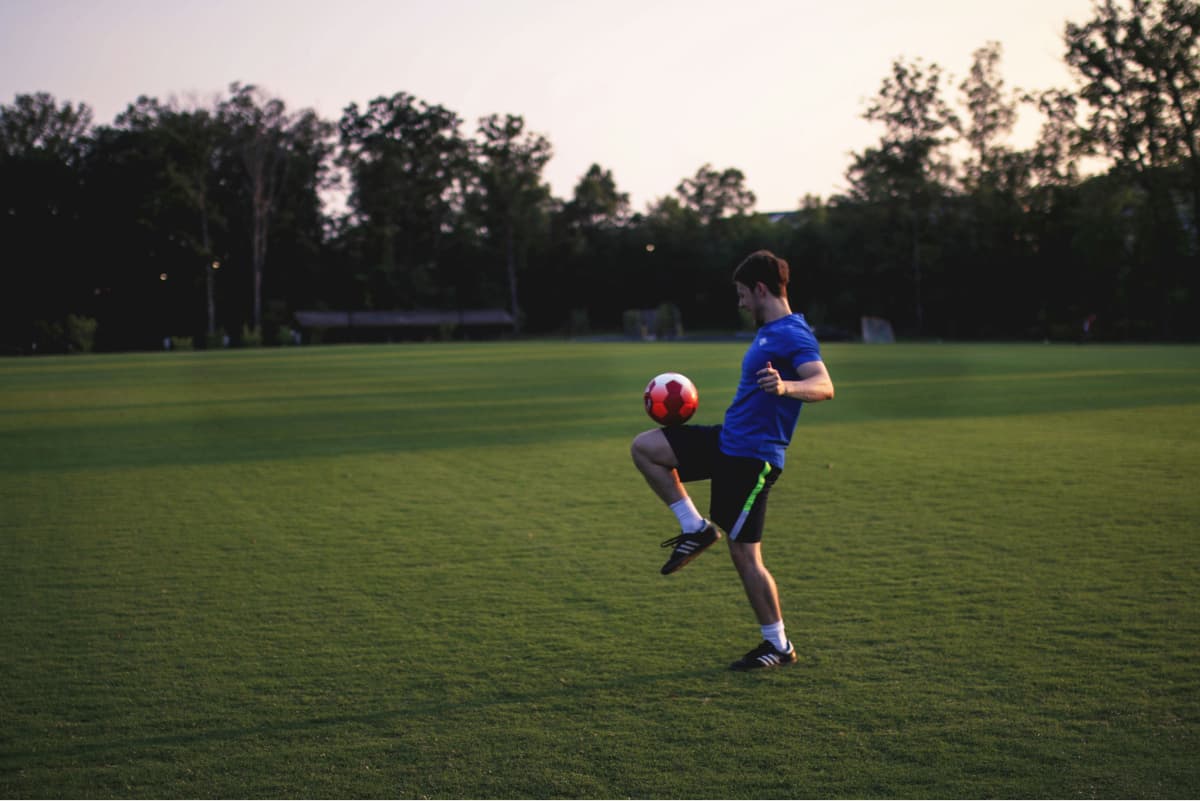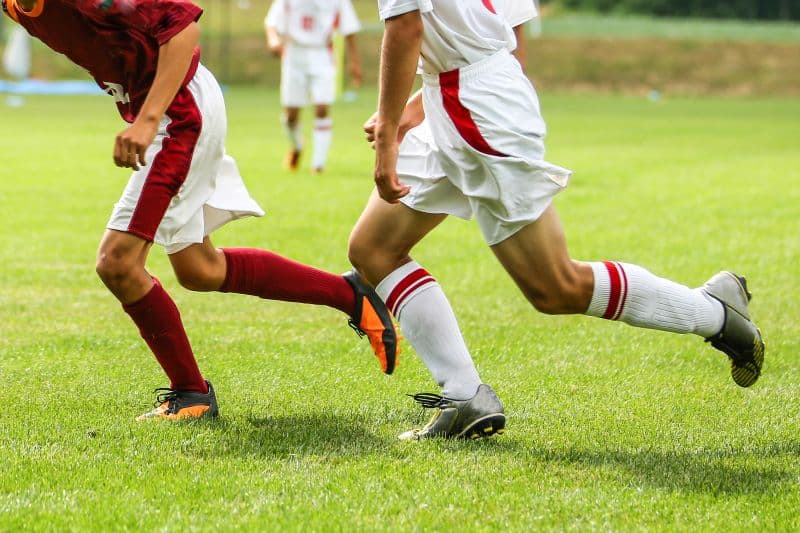Preseason soccer training is crucial for players of all levels, particularly youth and amateur players to make important strides in performance. The preparatory phase sets the tone for the upcoming season by building physical fitness, technical skills, and tactical understanding.
The period includes rigorous training designed to push your limits, enabling you to develop the physical and mental resilience needed to excel on the field. As the saying goes, “You get out what you put in,” which is especially true in the grueling and rewarding soccer preseason training.
In this article, we’ll break down the importance of pre-season training and how to have a successful pre-season:
What is Preseason Soccer Training?
Soccer preseason training is the period before the start of the season. During this time, you will engage in intensive physical, technical, and mental training to prepare for the needs of the upcoming matches.
The phase lasts several weeks and is designed to gradually increase intensity to ensure peak performance at the start of the season.
If you’re a professional soccer player, the season is rigorous and long; therefore, the correct preseason training is fundamental.
The Importance and Benefits of Preseason Soccer Training
The benefits of soccer preseason training extend beyond mere physical conditioning; it’s a comprehensive preparation period laying the foundation for a successful season.
Here are 4 of the key benefits:
1. Improved Physical Fitness
Preseason is where soccer players develop their fitness to enhance endurance, strength, and overall athletic performance.
The 3 most common ways to improve physical fitness include:
- Long-distance runs: Running moderately helps build a strong aerobic base. This improves your ability to sustain effort over the 90 minutes of a game.
- Interval training: It’s important to alternate between high-intensity running and recovery. For instance, you can sprint for 30 seconds or jog for a minute to simulate the intensity of a soccer match and improve aerobic and anaerobic capacity.
- High-intensity interval training (HIIT): You should conduct short bursts of exercise followed by rest periods. HIIT can enhance cardiovascular fitness and burn more calories, resulting in better conditioning before the season starts.
Soccer players will combine these exercises to remain fit, agile, and injury-free throughout the season.
2. Increased Technical Skill Development
You must build technical skills to refine ball handling, passing accuracy, and shooting precision. Although physical fitness is critical, without technical skill development it’s all irrelevant.
Here’s how you can enhance technical skill development:
- 1v1 Drills: You should stimulate game-like scenarios where you must maneuver past defenders to improve your ability to retain possession under pressure.
- Combination Play: Involves practicing sequences of passes, emphasizing movement, timing, and coordination with your teammates.
- Ball Mastery: You should engage in exercises involving repetitive ball touches with different parts of the foot; this will enhance your ball control.
3. Greater Tactical Awareness
Tactical awareness is essential for understanding and implementing team strategies and formations. It includes recognizing game situations and making smart decisions.
Here’s how you can develop tactical awareness:
- Video analysis: You can review game footage to understand positioning, movement, and decision-making; this helps you learn from your performances and those of professional players.
- Tactical breakdowns: Your coaches can provide detailed analyses of tactics, formations, and strategies, which helps you understand roles and responsibilities within different systems.
- Small-sided games: Playing in smaller teams on reduced-size fields encourages quick thinking and helps you understand spacing and positioning.
4. Enhanced Team Chemistry
Building strong team chemistry is crucial for cohesive play and overall team success. The most successful soccer teams during the season will have high chemistry levels.
Here’s how you can build team chemistry during preseason soccer training:
- Team-building activities: You can engage in activities beyond soccer, such as team outings, dinners, or recreational games, to help players bond and develop trust.
- Team retreats: Spending time together in a different environment, such as a team camp or retreat, fosters deeper connections and unity.
- Leadership roles: Encouraging players to take on leadership roles within the team, such as captains or mentors, promotes a sense of responsibility and unity.
3 Phases of Preseason Soccer Training
Phase 1: Building Base Fitness
A substantial aerobic base is essential for high performance throughout the soccer season. The initial phase focuses on building endurance and stamina—both crucial for maintaining energy levels during matches.
Here are the most common soccer pre-season fitness drills:
- Running drills: You must include long-distance runs and interval training to boost cardiovascular fitness. During long-distance runs, keep your average HR in the zone 1 to 3 region for maximum aerobic gains.
- Circuit training: You can also combine cardio with bodyweight exercises to improve overall fitness. Soccer matches are taxing on the body, so bodyweight exercises are essential for reducing injuries alongside your elite cardio conditioning.
- Cross-training options: You should also engage in swimming or cycling as low-impact alternatives to traditional running. This will keep your legs fresh and free from injuries.
- Fartlek Training: You should add fartlek training, which involves alternating between fast and slow running, to your workouts. This approach can mimic the unpredictable changes in pace and intensity that occur during soccer matches.
- Hill Sprints: You must also include hill sprints in your training program to build strength and power in your lower body while improving cardiovascular fitness. Running uphill requires greater effort and recruits more muscle fibers, making it excellent for enhancing speed and endurance.
However, gradually increasing the training volume and intensity during this phase is important. Likewise, injury prevention exercises—such as dynamic stretching and foam rolling—should also be integrated into the routine to promote a faster recovery.
Phase 2: Strength & Agility Development
Your second phase focuses on enhancing strength and agility, two crucial components for explosive movements and quick direction changes during games.
Here are the most important training methods:
- Strength training: It’s essential to include weightlifting exercises targeting major muscle groups, such as squats, lunges, and deadlifts, during preseason soccer training. These will improve your soccer performance and reduce injury during the pre-season.
- Plyometric exercises: You can include jump training to improve explosive power. These are important if you’re in the penalty box during corners or free kicks.
- Agility drills: You should utilize ladder drills, cone drills, and shuttle runs to enhance quickness and coordination. Regardless of your position on the field, agility drills are critical for better performance.
- Dribbling drills: You can practice various dribbling techniques—such as close control, changes of direction, and speed dribbling—through cone or obstacle courses. These drills are especially essential if you’re a striker or midfielder.
- Shooting drills: You should work on different shots, including volleys, half-volleys, and shots, from various angles and distances. Again, these drills are essential for strikers or midfielders.
However, you should slowly increase your workout intensity. As a result, you will build power without risking injury.
Phase 3: Skills and Tactics
The final phase focuses on technical skills and tactical knowledge, preparing you for the specific demands of competitive matches.
The most common training methods include:
- Tactical Formations: You can practice different team formations and strategies, such as 4-4-2, 4-3-3, and 3-5-2. Understanding and executing these formations is crucial for effective team play.
- Set Piece Drills: Work on free kicks, corner kicks, and throw-ins. This includes practicing offensive and defensive set pieces to enhance your team’s scoring opportunities and defensive solidity.
- Positional Play: You should engage in drills that simulate match conditions emphasizing positional responsibilities. This helps you understand your role and positioning in various game scenarios.
- Pressing and Defensive Drills: You should practice pressing as a team and individual defensive techniques. This includes drills on how to press high up the pitch, defending in a low block, and individual tackling and marking techniques.
These drills sharpen individual skills and help integrate them into team play, ensuring you can execute tactics effectively during games.
Preseason Soccer Training Tips
To maximize the benefits of pre-season training, we’ve compiled six key tips for high performance:
1. Listen to Your Body
You should avoid overtraining at all costs; pushing yourself too hard too soon can lead to fatigue, burnout, and injury. Therefore, recognize the signs of overtraining: persistent soreness, decreased performance, and lack of enthusiasm for training.
Likewise, you must focus on gradual increases; for instance, start with lower intensity and gradually increase the volume and intensity of your workouts. This lets your body adapt to the increased demands without overloading it.
Furthermore, incorporate adequate rest days into your training schedule; use recovery techniques like stretching, foam rolling, and massage to help your muscles recover.
2. Stay Hydrated
Proper hydration is essential for maintaining peak performance and promoting recovery. Dehydration can lead to decreased performance, increased risk of injury, and slower recovery times.
You should drink water regularly throughout the day—not just during training sessions. Sports drinks like Gatorade are beneficial during intense or prolonged training to replace lost electrolytes.
You can also develop a hydration schedule that includes drinking before, during, and after training. For example, drink 500 ml of water 2 hours before, 200 ml every 20 minutes during, and rehydrate fully post-training.
3. Nutrition
You should fuel your body with the right nutrients to support intense training, including a balance of carbohydrates, proteins, and fats.
- Carbohydrates: Essential for energy. Focus on complex carbs like whole grains, fruits, and vegetables.
- Proteins: Crucial for muscle repair and growth. Include lean meats, fish, eggs, and plant-based proteins.
- Fats: Necessary for overall health. Incorporate healthy fats from nuts, seeds, avocados, and olive oil.
You should also focus on meal timing to ensure enough energy for training and recovery. Aim to eat a balanced meal 2-3 hours before and a recovery meal or snack within 30 minutes post-training. Alongside hydration, consider supplements like protein shakes and BCAAs.
4. Set Realistic Goals
Setting realistic goals is critical for high performance, with SMART goals being one of the most popular options.
The SMART approach ensures your goals are well-defined and attainable:
- Specific: Define exactly what you want to achieve.
- Measurable: Determine how you will measure progress.
- Achievable: Set goals that are challenging yet attainable.
- Relevant: Ensure your goals align with your overall objectives.
- Time-bound: Set a deadline for achieving your goals.
In addition, keep a training journal or use a digital app to log your workouts, monitor improvements, and stay motivated. Also, regularly review and adjust your goals based on your progress.
5. Injury Prevention
One of the most significant factors preventing a successful season is injury. Thankfully, you can stop many injuries with a solid pre-season camp.
You should always start your training sessions with a thorough warm-up to prepare your muscles and joints for the workout. You can also include dynamic stretches and light cardio activities.
Likewise, use exercises that improve flexibility and mobility to maintain a full range of motion and reduce the likelihood of strains and sprains.
6. Mental Preparation
You should include mental toughness training exercises into your preseason regimen. This could contain simulated game scenarios, adversity training, and visualization drills designed to challenge and strengthen mental resilience.
In addition, instead of shying away from challenges, view them as opportunities for growth and embrace adversity during training sessions and scrimmages.
Use Technology to Optimize Preseason Training
Incorporating technology into your preseason regimen can provide significant advantages. Playermaker’s smart soccer tracker offers data-driven insights to optimize training and monitor progress.
How Playermaker can help your soccer preseason training:
- Performance tracking: Monitor key metrics such as distance covered, speed, and heart rate to tailor training plans.
- Skill analysis: You should evaluate technical skills with precision, helping to find areas for improvement.
- Injury prevention: Use data to detect early signs of overtraining or potential injuries, which allows for timely interventions.
Final Thoughts
A pre season training program for soccer is pivotal for players—especially youth and amateurs aiming to elevate their game. If you focus on building fitness, developing skills, and understanding tactics, you can set yourself up for a successful and fulfilling season.
Ensure you embrace the preseason grind with a data-driven approach, and you’ll see the results on the field.







